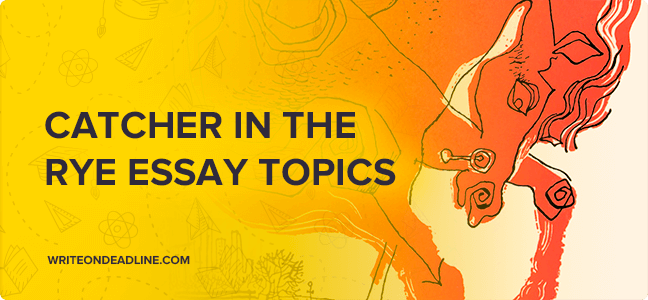55 Catcher in the Rye Essay Topics

J.D. Salinger’s “The Catcher in the Rye” remains a quintessential piece of American literature. The story delves deep into the three-day journey of 17-year-old Holden in Manhattan after his expulsion from prep school, capturing the nuances of his initiation into adulthood. The novel extensively underlines the ideals of the American middle-class and employs humor and symbolism which resonate with high school and college students, making it a frequent educational reference.
However, understanding and extracting Salinger’s stylistic devices and thematic concerns can be tricky for those unfamiliar with the novel. This guide aims to facilitate the selection of engaging essay topics based on “The Catcher in the Rye” and provide exemplary topics and questions for your reference.
Table of Contents
Guide to Selecting an Engaging Catcher in the Rye Essay Topic
-
Comprehensive Reading: Before delving into topic selection, ensure a thorough reading of the novel. Jot down compelling ideas, characters, and literary devices encountered during the read.
-
Theme Identification: Recognize and understand the novel’s central themes. From the challenges of adolescence to the intricacies of human relationships, these themes provide a foundation for topic generation.
-
Staying Relevant: Your selected topic should be aligned with the novel’s content and not veer off into tangential discussions.
-
Originality: Given the novel’s popularity, many topics might feel overdone. Aim for a unique perspective or a fresh angle to make your essay stand out.
Inspiring Essay Topics Based on The Catcher in the Rye:
- Exploration of Holden’s relationships
- Symbols signifying the coming-of-age theme.
- Holden’s struggle between adolescence and isolation.
- Comparing Salinger’s style with that of “An American Tragedy.”
- Should “The Catcher in the Rye” be banned? Present your case.
- The portrayal of American outcast culture.
- Analyzing the novel’s key conflicts.
- Drawing parallels between “The Adventures of Huckleberry Finn” and Salinger’s masterpiece.
- Understanding Holden’s journey through the five stages of grief.
- The significance of the red hunting hat in the narrative.
Holden’s Relationships:
- The dynamic between Holden and Phoebe.
- Holden’s perception of adults versus children.
- His encounters with nuns and their influence on his worldview.
- The role of Mr. Antolini in Holden’s life.
- Understanding the significance of Holden’s relationship with Sally Hayes.
Symbols and Motifs:
- The Museum of Natural History and its representation of the static past.
- The ducks in Central Park and their symbolism.
- Holden’s red hunting hat and its ties to identity.
- The motif of “falling” and its significance in the novel.
- The carousel and its representation of life’s cyclic nature.
Societal Critiques:
- Holden’s perspective on societal hypocrisy.
- The critique of materialism in the novel.
- Holden’s confrontation with the adult world and its shortcomings.
- Salinger’s commentary on post-war American society.
- The portrayal of women in Holden’s world.
Mental Health Exploration:
- Understanding Holden’s depression.
- Holden’s fixation on death.
- The trauma from Allie’s death and its impact on Holden.
- Examining Holden’s narrative from a PTSD perspective.
- The potential reasons behind Holden’s hospitalization.
The Coming-of-Age Theme:
- How does Holden perceive adulthood?
- The challenges of growing up as presented in the novel.
- The instances when Holden showcases maturity.
- Holden’s resistance to becoming an adult.
- The moments when Holden embraces his youth.
Contrasts and Dualities:
- Innocence vs. experience in Holden’s life.
- Holden’s dual perspective: child vs. adult.
- Reality vs. fantasy in Holden’s escapades.
- Solitude vs. societal interaction.
- Holden’s inner conflict: fear of change vs. desire for connection.
Character Analysis:
- Examining Holden as an anti-hero.
- Phoebe’s role as a grounding force in Holden’s life.
- Mr. Antolini – a mentor or a menace?
- Analyzing the minor characters and their influence on Holden.
- The unseen influence of Allie on Holden’s decisions.
Literary Techniques:
- The use of unreliable narration in the novel.
- The significance of the title, “The Catcher in the Rye.”
- Salinger’s use of colloquial language to craft Holden’s voice.
- The impact of a first-person narrative in understanding Holden.
- Exploring the narrative pacing of Holden’s three days in New York.
Comparative Analysis:
- “The Catcher in the Rye” vs. “To Kill a Mockingbird”: Examining childhood.
- Salinger’s Holden and Mark Twain’s Huckleberry Finn: Rebels in their respective societies.
- Comparing the portrayal of New York City in Salinger’s novel and F. Scott Fitzgerald’s “The Great Gatsby.”
- “The Catcher in the Rye” and “Lord of the Flies”: Analyzing lost innocence.
- Holden Caulfield vs. Jay Gatsby: Dreams, delusions, and downfalls.
Provocative Essay Questions for Consideration:
- Is Holden an archetype of sanity in an insane world?
- Can Holden ever find his true self?
- What drives Holden’s disdain for “phonies”?
- Does Holden grapple with his dual identities as a child and an adult?
Additional Essay Ideas: Consider juxtaposing “The Catcher in the Rye” with contemporary works like Stephen Chbosky’s “The Perks of Being a Wallflower” or John Green’s “Looking for Alaska”. Dive into the novel’s controversial ties with historical events, such as the attempted assassination of Ronald Reagan or the murder of John Lennon.
Seeking Professional Assistance?
Struggling to get started? Consider leveraging professional writing services. WriteOnDeadline offers tailored solutions for students seeking expert essay writing assistance. Our native writers, equipped with academic prowess and vast experience, have helped countless students craft compelling essays. If you’re striving for a top-tier essay on this classic novel, we’re here to help!

